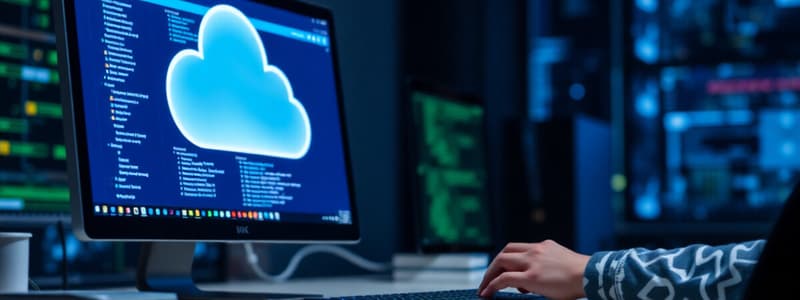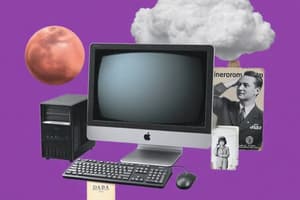Podcast
Questions and Answers
Which of the following exemplifies the overarching goal of End-User Computing (EUC)?
Which of the following exemplifies the overarching goal of End-User Computing (EUC)?
- To replace professional programmers with end-users for complex software development.
- To ensure all computing tasks are development related.
- To provide end-users with computing environments they can control without relying on developers. (correct)
- To restrict the use of computers to only those tasks defined by IT professionals.
When an organization adopts end-user development (EUD), what computing facilities might end-users need access to?
When an organization adopts end-user development (EUD), what computing facilities might end-users need access to?
- No additional computing resources are needed.
- Only their personal devices for development.
- Only the software training tools.
- Computer workstations, network access, and software training tools. (correct)
How do virtual desktops and applications enhance mobility and connectivity in End-User Computing (EUC)?
How do virtual desktops and applications enhance mobility and connectivity in End-User Computing (EUC)?
- By requiring specific hardware and software specifications.
- By eliminating the need for specific hardware and software, supporting BYOD. (correct)
- By being offered 'as-a-product' rather than 'as-a-service'.
- By limiting access to desktop applications only.
Which of the following is a potential risk associated with End-User Computing (EUC)?
Which of the following is a potential risk associated with End-User Computing (EUC)?
What characterizes fourth-generation programming languages in the context of End-User Computing (EUC)?
What characterizes fourth-generation programming languages in the context of End-User Computing (EUC)?
In an organization that has successfully implemented End-User Computing (EUC), how might the role of DP (Data Processing) professionals change?
In an organization that has successfully implemented End-User Computing (EUC), how might the role of DP (Data Processing) professionals change?
How does the implementation of End-User Computing (EUC) potentially address system implementation problems?
How does the implementation of End-User Computing (EUC) potentially address system implementation problems?
What is a key characteristic of application packages within End-User Computing (EUC)?
What is a key characteristic of application packages within End-User Computing (EUC)?
Which statement correctly describes the relationship between End-User Computing (EUC) and End-User Development (EUD)?
Which statement correctly describes the relationship between End-User Computing (EUC) and End-User Development (EUD)?
Why might end-user developed software pose a security risk to an organization?
Why might end-user developed software pose a security risk to an organization?
How does Office Automation (OA) aim to improve organizational efficiency?
How does Office Automation (OA) aim to improve organizational efficiency?
What role does networking play in an Office Information System (OIS)?
What role does networking play in an Office Information System (OIS)?
How does the use of functions in office automation software enhance productivity?
How does the use of functions in office automation software enhance productivity?
Which of the following is not a typical capability of process software used in office automation?
Which of the following is not a typical capability of process software used in office automation?
What is the primary purpose of electronic spreadsheet software in office environments?
What is the primary purpose of electronic spreadsheet software in office environments?
How does graphics design software enhance presentations in a business setting?
How does graphics design software enhance presentations in a business setting?
Which of the following is a capability typically provided by calendar software in an office environment?
Which of the following is a capability typically provided by calendar software in an office environment?
How does electronic communication software enhance office productivity?
How does electronic communication software enhance office productivity?
In project management software, how are changes in assumptions and estimates typically managed?
In project management software, how are changes in assumptions and estimates typically managed?
What is the primary goal of an Office Information System (OIS)?
What is the primary goal of an Office Information System (OIS)?
Flashcards
End-User Computing (EUC)
End-User Computing (EUC)
Computer setups allowing non-programmers to create applications, control computing environments without needing developers.
End-User Development (EUD)
End-User Development (EUD)
Practice allowing end-users to develop IT systems, often with support from IT professionals.
Enhanced Productivity
Enhanced Productivity
Helps streamline processes through IT systems and automation.
Empowerment of End-users
Empowerment of End-users
Signup and view all the flashcards
Reduction/Elimination of Steps
Reduction/Elimination of Steps
Signup and view all the flashcards
Overcoming DP Shortage
Overcoming DP Shortage
Signup and view all the flashcards
User-Friendly Systems
User-Friendly Systems
Signup and view all the flashcards
Application Packages
Application Packages
Signup and view all the flashcards
4th Gen. Programming Languages
4th Gen. Programming Languages
Signup and view all the flashcards
Office Automation?
Office Automation?
Signup and view all the flashcards
Office Information System (OIS)
Office Information System (OIS)
Signup and view all the flashcards
Functions
Functions
Signup and view all the flashcards
Software Packages
Software Packages
Signup and view all the flashcards
Process Software
Process Software
Signup and view all the flashcards
Word Processing
Word Processing
Signup and view all the flashcards
Electronic Spreadsheet
Electronic Spreadsheet
Signup and view all the flashcards
Database Management
Database Management
Signup and view all the flashcards
Desktop Publishing
Desktop Publishing
Signup and view all the flashcards
Project Management
Project Management
Signup and view all the flashcards
Electronic Communication
Electronic Communication
Signup and view all the flashcards
Study Notes
End-User Computing (EUC) Defined
- Involves computer systems and platforms designed for non-programmers (End-Users)
- Enables the creation of working applications and outputs
- Uses tools and techniques to involve people with minimal programming experience in computing systems development
- Allows end-users to control their computing environment independently
- Includes all computer use by end-users for whom programmers develop applications
- Encompasses all computing activities not directly related to development
Types of EUC Resources
- Desktop and Laptop Computers: Common hardware, customisable based on user needs
- Desktop Operating Systems and Applications: Software aspect, either pre-packaged or sold/developed separately
- Smartphones and Wearables: Mobile hardware platforms with associated software (apps and widgets)
- Mobile, Web, and Cloud Applications: Prioritizes mobility and connectivity, typically offered as services
- Virtual Desktops and Applications: Enhances mobility and connectivity through online, cloud-based solutions, reducing the need for specific hardware and software, exemplified by virtual workplace suites like Microsoft Office 365
End-User Development (EUD)
- A practice within EUC where end-users develop information systems with IT support
- Requires providing end-users with computing facilities like workstations, network access, and training tools
Benefits of EUC and EUD
- Enhanced productivity: Increases productivity through information systems and process automation
- Empowerment of end-users: Empowers members by enabling them to create system solutions
- Streamlined processes: Application development improves/revises business processes for efficiency
- Reduced reliance on DP professionals: Equipping end-users with software training minimizes the need for IT resources
- User-friendly Systems: Directly involved end-users develop simpler, responsive systems
- Addresses implementation challenges: Users develop their own systems eliminating implementation issues
Risks Associated with EUC
- Errors in Analysis: Inadequate training leads to questionable software quality because end-users may misanalyze data or systems
- Lack of Documentation: Informal analysis and design result in inadequate documentation, complicating maintenance
- Faulty Models: Decision Support Systems (DSS) rely on end-user-created corporate models with potential errors. Studies suggest 38% of spreadsheets may have errors
- Security and Piracy Issues: Lack of security measures and access to computing assets may expose data to manipulation or theft
Classes of End-User Computing (EUC) Tools
- Application Packages: Commercially marketed software that supports standard business functions
- Examples: Payroll, ledgers, scheduling, inventory control.
- often customizable through parameters
- Example: Microsoft Office Suite
- Fourth-Generation Programming Languages: Programming languages that empower end-users to create computing solutions and consolidate them into small information systems
- Often can run on most computer types
- Example: SQL query language for database management.
End-User System Tools
- Text and Multimedia Handling: Includes word processing, desktop publishing, web-publishing, presentation software, document/workflow management systems
- Data Handling: Includes spreadsheets, statistical/decision support packages, and databases
- Communication: Includes e-mail, VoIP, fax, WAP, pagers
- Office Automation: Includes diary management, notebooks, directories, project management, and personal digital assistants, along with Bluetooth
- Group Systems/Computer Supported Collaborative Work: Includes teleconferencing and virtual workspaces/desktops
- Graphic Design: Computer-aided design and graphic software
- Knowledge Management: Includes expert systems, data mining, and information retrieval
Office Automation
- Refers to integrated office requirements within an organization
- Includes word processing, data filing, diary management, and communications
- Aims to streamline functions and reduce additional workforce
Office Information System (OIS) Defined
- A system that uses software, hardware, and networking to improve workflow and communication
- Supports business activities for management and workforce efficiency
- Evolves and automates to increase flexibility and effectiveness
Abilities of an OIS
- Facilitates electronic communication through e-mail and instant messaging
- Manages audio-video communication via telephony and teleconferencing systems
- Facilitates record management using databases or data servers
- Automates business processes to reduce manpower requirements
- Provides EUC to enhance employee efficiency
Tools Available via Office Automation and OIS
- Functions: Operations performed via function keys like Cut, Copy, Paste, etc
- Software Packages: Interacting bundled applications that provide specific functionality, like Microsoft Office Suite and Google Docs
- Process Software: Individual or bundled software offering specific capabilities, like Autodesk’s AutoCAD
- Word Processing: Software for developing and formatting textual documents, exemplified by Notepad and Microsoft Word
- Electronic Spreadsheet: Software for accounting and financial tasks that maintains, manipulates, and calculates numerical data, like Microsoft Excel
- Database Management: Enables organized electronic information/file storage, like Microsoft Access and MySQL
- Desktop Publishing: Laying out text/graphics on a page, blurring distiction between word processing software
- Graphics Design: Creating charts/graphs from spreadsheets or user input. An example is Microsoft PowerPoint
- Project Management: Identifying tasks, resources, and timelines, exemplified by project management software
- Calendar: Scheduling and project time management. Increasingly integrated over platforms and systems
- Electronic Communication: Software lets users send info, exemplified by Microsoft Outlook
Studying That Suits You
Use AI to generate personalized quizzes and flashcards to suit your learning preferences.



